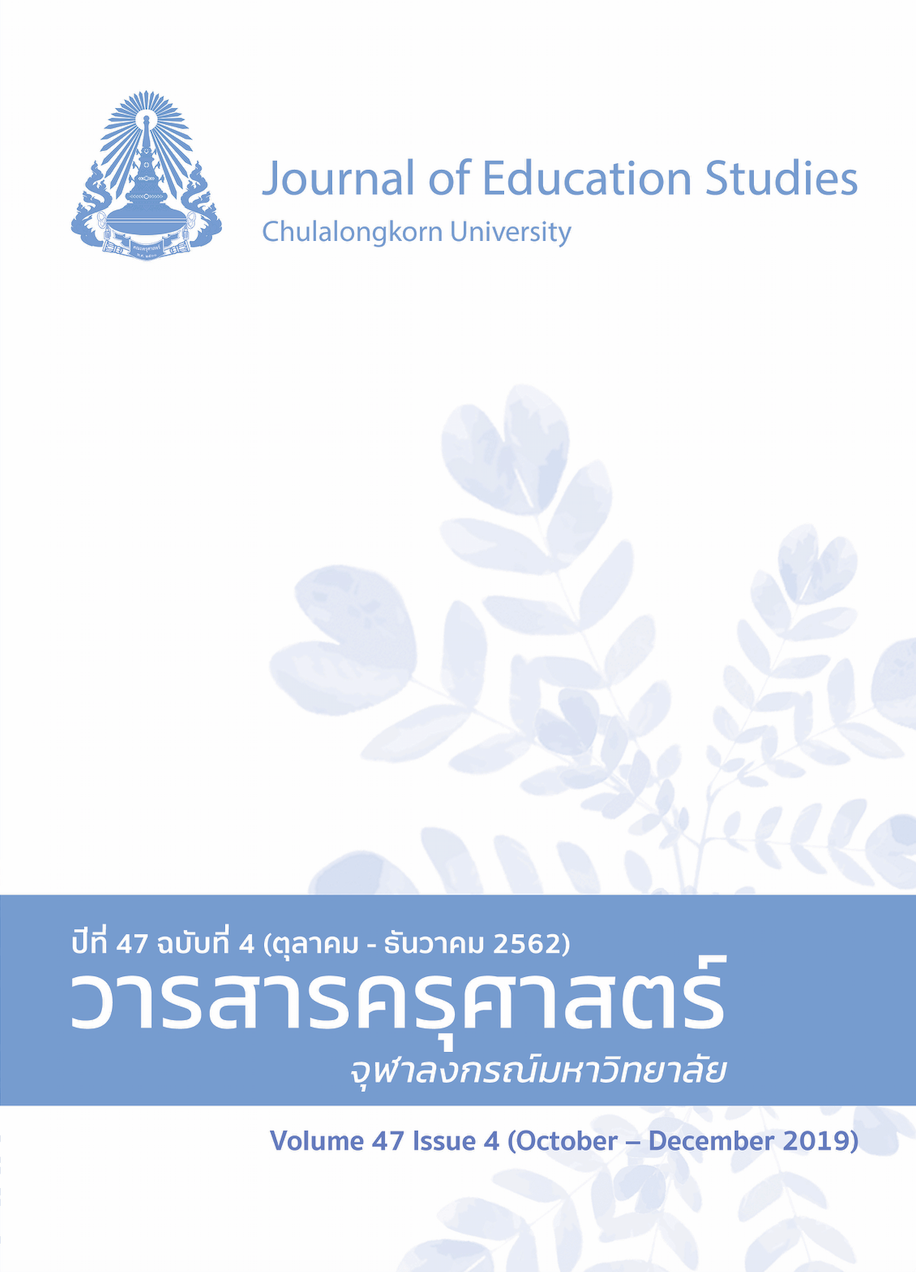Exploratory Factor Analysis of Formative Leadership of School Directors under the Primary Educational Service Area Office
Keywords:
FORMATIVE LEADERSHIP, EXPLORATORY FACTOR ANALYSIS, SCHOOL DIRECTORSAbstract
The objective of this research was to study exploratory factors of formative leadership. The sample comprised 375 school directors under the primary education service area office, using multi-step random methods. The tool used for data collection was the formative leadership questionnaire with the index of correspondence equal to 0.88. Data collection began in January 2018 and the data was analyzed using exploratory factor analysis (EFA). The factor was extracted by using the Varimax Orthogonal Axis Rotation technique. Factor analysis of formative leadership among the school directors resulted in 37 non-identity matrix variables. (Bartlett’s test: 2=28487.57, df=666, p=.00-), and the value KMO=0.89. The analysis of variables after Varimax rotation resulted in 10 factors, including 1) Teamwork 2) Leadership 3) Trust 4) Creativity 5) Human resources 6) Service 7) Communication 8) Human relationships 9) Power distribution, and 10) Change management, which had a variance of 95.23 percent. The teamwork factor had the highest variance (44.85 percent) and the change management factor had the lowest variance (2.71 percent). Thus, improvement of formative leadership should consider these 10 factors.
References
กรองทิพย์ นาควิเชตร. (2552). ภาวะผู้นำสร้างสรรค์เพื่อการศึกษา. กรุงเทพมหานคร: ธีรสาส์น พับลิชเชอร์.
กิตติยา ผ่านเมือง, วาโร เพ็งสวัสดิ์, และ ปารณทัตต์ แสนวิเศษ. (2560). การพัฒนารูปแบบการสร้างความ สัมพันธ์ระหว่างโรงเรียนกับชุมชน ในสังกัดสำนักงานเขตพื้นที่การศึกษาประถมศึกษาอุบลราชธานี เขต 2. วารสารบัณฑิตศึกษา, 14(64), 51-59.
ขวัญเมือง แก้วดำเกิง, จำเนียร ชุณหโสภาค, และ ดวงเนตร ธรรมกุล. (2558). ปัจจัยสร้างสุของค์กรภาคเอกชนในประเทศไทย. วารสารวิธีวิทยาการวิจัย, 28(1), 95-111.
ชูชาติ พ่วงสมจิตร์. (2560). การสร้างความสัมพันธ์ระหว่างโรงเรียนกับชุมชน. Veridian E-Journal, Silpakorn University, ฉบับภาษาไทย สาขามนุษยศาสตร์ สังคมศาสตร์ และศิลปะ, 10(2), 1341-1354.
ธีระ รุญเจริญ. (2553). การบริหารโรงเรียนยุคปฏิรูปการศึกษา. กรุงเทพมหานคร: ข้าวฟ่าง.
นงลักษณ์ วิรัชชัย. (2542). โมเดลลิสเรล: สถิติวิเคราะห์สำหรับการวิจัย (พิมพ์ครั้งที่ 3). กรุงเทพมหานคร: โรงพิมพ์แห่งจุฬาลงกรณ์มหาวิทยาลัย.
ปิยะพงษ์ ทองดี. (2561). ภาวะผู้นำขององค์การสมัยใหม่. วารสารร่มพฤกษ์ มหาวิทยาลัยเกริก, 36(1), 67-87.
ไพฑูรย์ สินลารัตน์. (2554). CCPR กรองคิดใหม่ทางการศึกษา. กรุงเทพมหานคร: จุฬาลงกรณ์มหาวิทยาลัย.
ยุทธ์ ไกรวรรณ. (2556). การวิเคราะห์สถิติหลายตัวแปรสำหรับงานวิจัย. กรุงเทพมหานคร: สำนักพิมพ์จุฬาลงกรณ์มหาวิทยาลัย.
รวิภา ธรรมโชติ. (2561). นวัตกรรมการบริหารทรัพยากรมนุษย์ของไทยเพื่อสร้างความได้เปรียบในการแข่งขันในประชาคมอาเซียน กรณีศึกษา บริษัทปูนซิเมนต์ไทย มหาชน จำกัด และบริษัท แอดวานซ์ อินโฟร์ เซอร์วิส จำกัด (มหาชน). วารสารรัชตภาคย์, 12(26), 186-198.
วิโรจน์ สารรัตนะ. (2555). แนวคิด ทฤษฎี และประเด็นเพื่อการบริหารทางการศึกษา (พิมพ์ครั้งที่ 8). กรุงเทพมหานคร: ทิพยวิสุทธิ์.
สุเทพ พงศ์ศรีวัฒน์. (2557). ภาวะความเป็นผู้นำ. กรุงเทพมหานคร: เอ็กซเปอร์เน็ท.
สุภมาส อังศุโชติ, สมถวิล วิจิตวรรณา, และ รัชนีกูล ภิญโญภานุวัฒน์. (2552). สถิติวิเคราะห์สำหรับการวิจัยทางสังคมศาสตร์และพฤติกรรมการศาสตร์ เทคนิคการใช้โปรแกรม Lisrel (พิมพ์ครั้งที่ 3). กรุงเทพมหานคร: เจริญดีมั่นคงการพิมพ์.
สำนักวิชาการและมาตรฐานการศึกษา. (2560). แนวทางการพัฒนาและประเมินค่านิยมหลักของคนไทย 12 ประการ. สำนักวิชาการและมาตรฐานการศึกษา. กรุงเทพมหานคร: พริกหวานกราฟฟิค.
อรอร ภู่เจริญ. (2562). ยุทธศาสตร์การพัฒนาของสิงค์โปร์ในยุคบูรพาภิวัฒน์: บทเรียนต่อประเทศไทย. สืบค้นจาก https://www.slideshare.net/Klangpanya/ss-47549281
ภาษาอังกฤษ
Ash, R. C., & Persall, J. M. (1999). The principal as chief learning officer. National Association of Secondary School Principals, 84(616), 15-22.
Basadur, M. (2004). Leading other to think innovatively together: Creative leadership. Journal of the Leadership Quarterly, 15(1), 103-121
Bosiok, D. (2013). Leadership styles and creativity. Online Journal of Applied Knowledge Management, 1(2), 64-77.
Delich, V. (2010). The impact of Mercosur’s sanitary and phytosanitary regime on its member’s institutional dynamics. Journal of CMA Management, 79(2), 3-3.
Faguet, J. P., & Sanchez, F. (2008). Decentralization’s effects on educational outcomes in Bolivia and Colombia. World Development, 36(7), 1294-1316.
Harris, A. (2009). Creative leadership. Journal of Management in Education, 23(1), 9-11.
Hauge, T. E., Norenes, S. O., & Vedøy, G. (2014). School leadership and educational change: Tools and practices in shared school leadership development. J Educ Change, 15(4), 357–376.
Healey, J. (2007). Radical trust: How today’s great leaders convert people to partners. Canada: John Wiley & Sons, Inc.
Hatch, W. F. (2010). Asia’s flying geese: How regionalization shapes Japan. Ithaca: Cornell University Press.
Hoffman, K. D., & Bateson, J. E. G. (2006). Services marketing: Concepts, strategies, & cases. Mason, OH: Thomson South-Western.
Kelly, C., & Halverson, R. (2012). The comprehensive assessment of leadership for learning: A next generation formative evaluation and feedback system. Journal of Applied Research on Children: Informing Policy for Children at Risk, 3(2/4), 1-22.
Krejcie, R. V., & Morgan, D. W. (1970). Determining sample size for research activities. Educational and Psychological Measurement, 30(3), 607-610.
Kwok, N., Hanig, S., Brown, D. J., & Shen, W. (2018). How leader role identity influences the process of leader emergence: A social network analysis. The Leadership Quarterly, 29(6), 648-662.
Ladegard, G., & Gjerde, S. (2014). Leadership coaching, leader role-efficacy, and trust in subordinates. A mixed methods study assessing leadership coaching as a leadership development tool. The Leadership Quarterly, 25(4), 631-646.
Lumsden, G., & Lumsden, D. (2003). Communicating with credibility and confidence diverse people. Diverse setting (2nd ed.). Belmost, CA: Thomson/Wodsworth.
Chew, M. M. M., Cheng, J. S., & Petrovic-Lazarevic, S. (2006). Manager’s role in implementing organizational change: Case of the restaurant industry in Melbourne. Journal of Global Business and Technology, 2(1), 58-67.
Parther, C. W. (2010). Manager’s guide to fostering innovation and creativity in terms. New York: McGraw–Hill.
Pietersen, W. (2002). The Mark Twain dilemma: the theory and practice of change leadership. Journal of Business Strategy, 23(5), 32-37.
Polizzi, S. J., Ofem, B., Coyle, W., Lundquist, K., & Rushton, G. T. (2019). The use of visual network scales in teacher leader development. Teaching and Teacher Education, 83, 42-53.
Turco, C. J. (2016). The conversational firm: Rethinking bureaucracy in the age of social media. New York: Columbia University Press.
Zaccaro, S. J., Green, J. P., Dubrow, S., & Kolze, M. J. (2018). Leader individual differences, situational parameters, and leadership outcomes: A comprehensive review and integration. The Leadership Quarterly, 29(1), 2-43.




